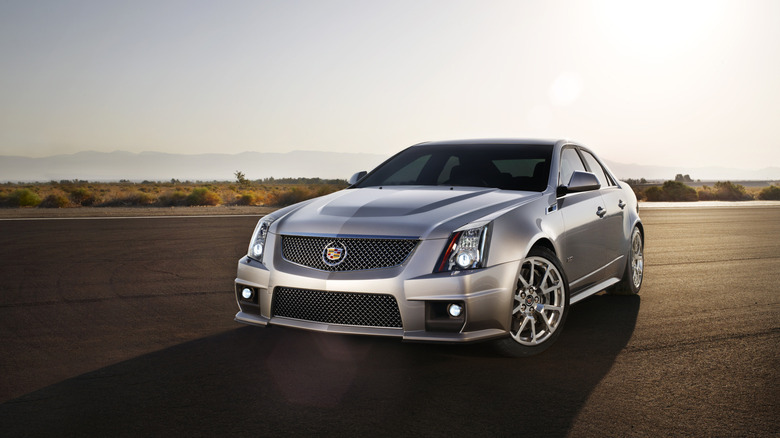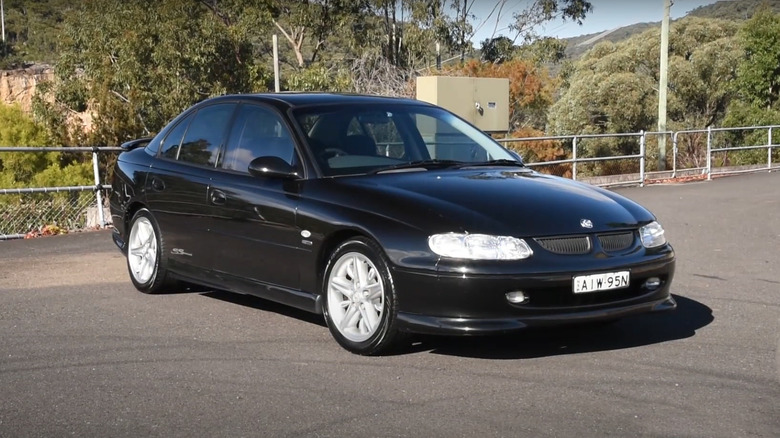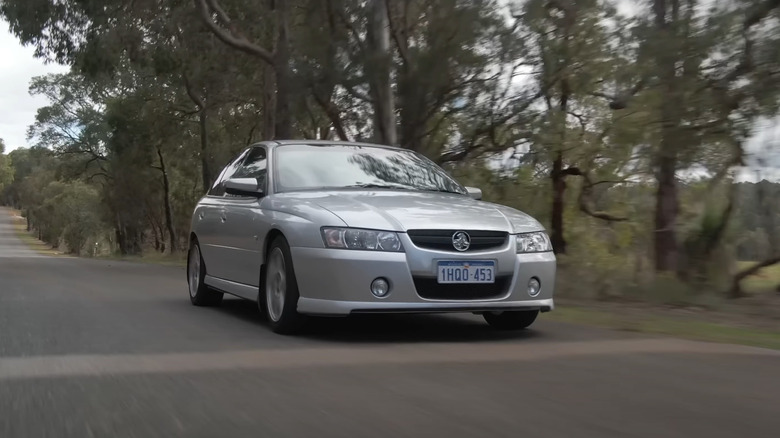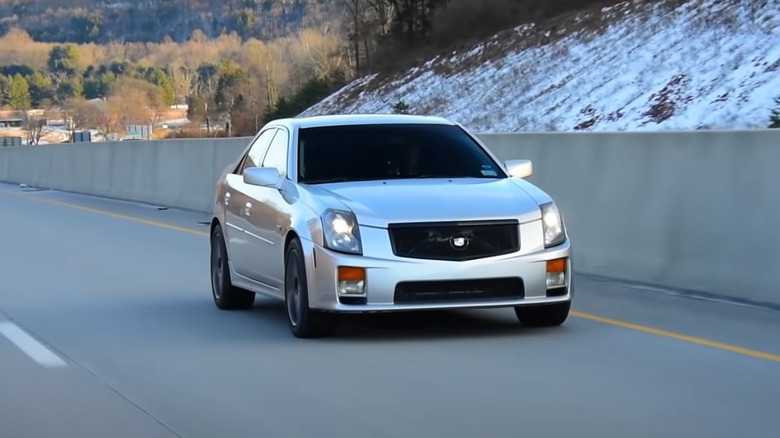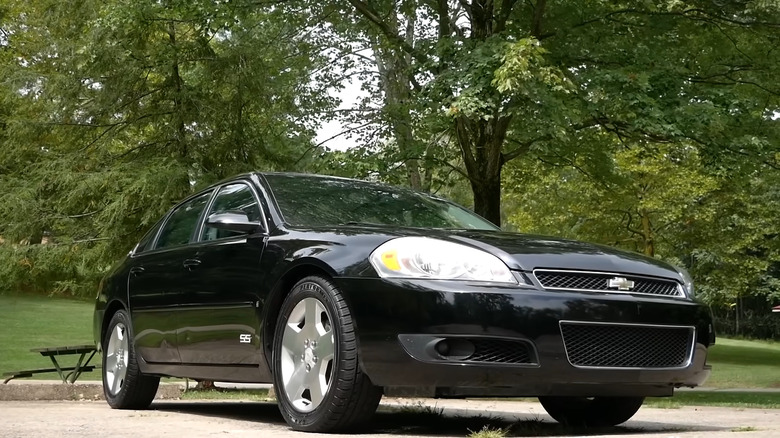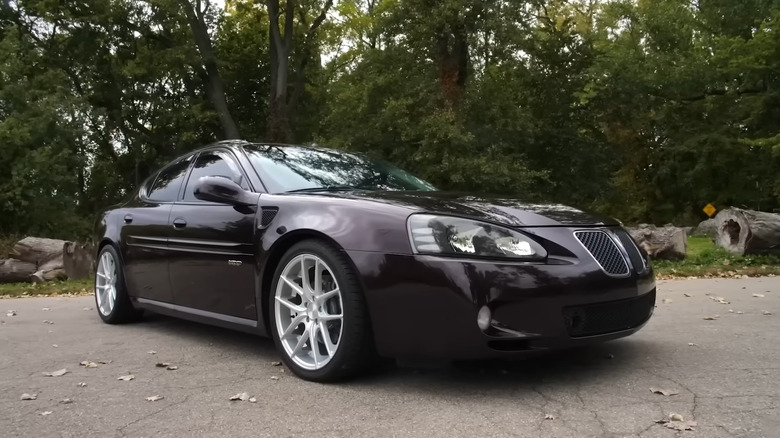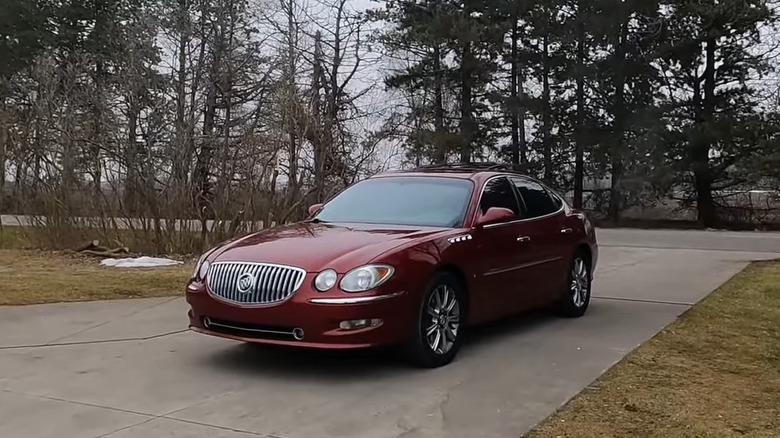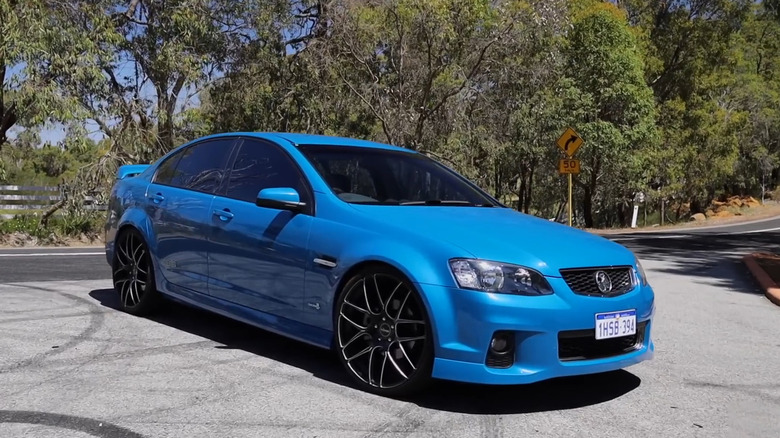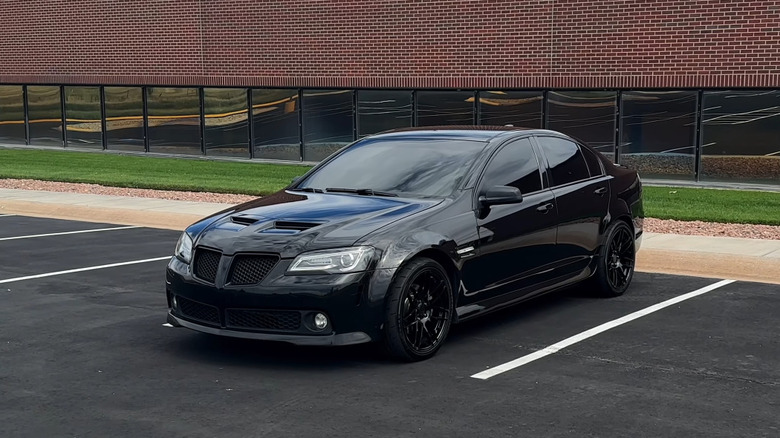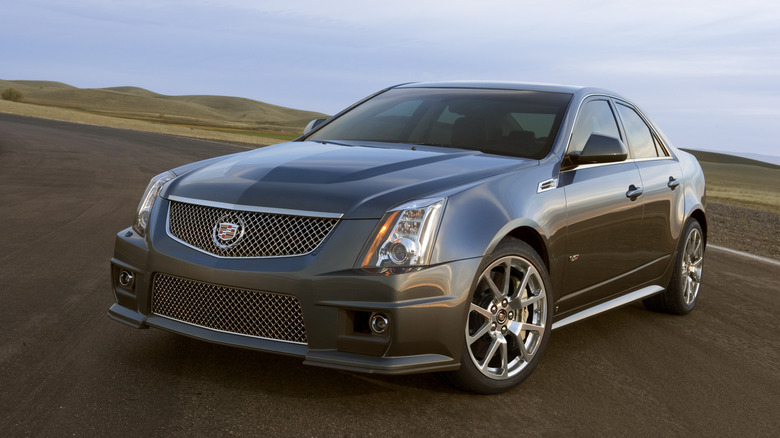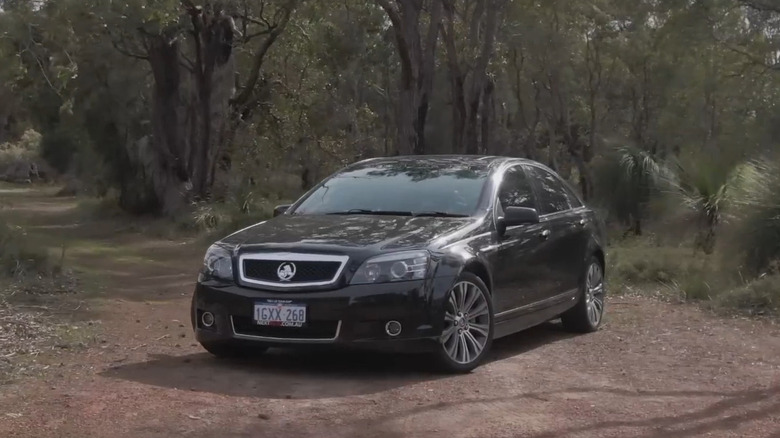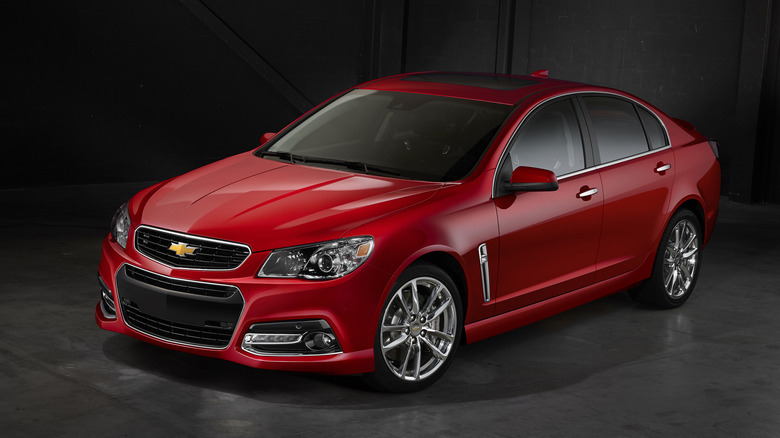Every Sedan Powered By The General Motors LS V8 Engine
Chevy's small-block LS V8 engines have become almost mythical by now. Some GM enthusiasts even get specific LS tattoos to show their love. It's hardly surprising, as the LS family has powered some incredible muscle cars through the years. They're quick, cheap, thunderous, and amazingly satisfying to drive. And don't get us started on LS swaps, because that's a culture on its own.
None of this is breaking news, but what might surprise you is that the almighty LS engine has also found its way into quite a few sedans. You might be scoffing at this claim and imagining Cadillac's LS-powered V-Series performance sedans, but we promise there are many more. In fact, most of them didn't even go to the V8-fanatic North America — the LS-powered sedan was a global development. Thirsty to know more about these exotic, tire-burning family haulers? Let's get started, because we have some fringe burnout machines that might pique your interest.
Holden Commodore SS VT (2000 - 2004)
Few sedans are better project cars than the first two generations of the Holden Commodore SS. These Australian-built sports sedans used Holden's 5.0-liter Iron Lions V8 initially (VT generation), which may sound interesting, but with only 243 hp on tap, the engine was underpowered for the large sedan.
So, Holden asked for help from its parent company, GM, and put the LS1 engine in the refreshed 1999 VT Commodore SS Series II. With a larger, 5.7-liter capacity, and 306 hp on tap, the first-ever LS engine brought some much-needed zest to the series. In the refreshed VX and VY models, the power increased to 320 hp. Crucially, though, the VX Series II got an extra toe-control linkage on the rear axle and new suspension bushings, which made the LS1-powered sedan much tighter in the corners.
Moreover, the LS1 didn't just bring more power — it was also much lighter than the Iron Lions V8, thanks to the aluminum block. Despite that, the block was very stiff, as GM used the sump as a stressed member. However, as LS enthusiasts probably know, the LS1 wasn't without its problems. Namely, due to the big intake ports, it was dead at low revolutions. Holden didn't help matters by using long gearing, which made the Commodore SS lazy off the line. And, yes, the LS1 also likes to get drunk on oil. Still, owners probably forgot about these issues once the LS1 reached above 3,000 rpm and started sounding quite angry.
Holden Commodore SS VZ (2004 - 2007)
The VZ Commodore SS was still based on the same platform as the previous versions, but it received some minor tweaks on the outside, and new aluminum V6 engines. On the V8 front, the LS1 engine was bumped to 335 hp, similar to what the C5 Corvette had. Paired with a six-speed manual, the upgraded LS1 gave the VZ Commodore SS a 0-62 mph time of 6.3 seconds.
Starting from 2006, though, the VZ got the 6.0-liter Gen IV L76 engine, which was a version of the LS2. Unlike the American versions of the L76, Holden's didn't have Displacement On Demand and variable valve timing, but it didn't matter. With 398 hp on tap, it offered much better performance. 0-62 mph with this motor took only 4.7 seconds, and its top speed was in excess of 168 mph. Like the previous version, the 6.0-liter VZ Commodore SS was available with a precise Tremec six-speed gearbox or four-speed automatic.
Curiously, Holden made the move to the larger engine because of tighter emission regulations. So, although it was a sizeable upgrade compared to all pre-facelift models, the VZ was very short-lived. The Commodore SS lineup needed a shakeup, and the 6.0-liter engine was only there to keep it a tad longer on the market. It wasn't even part of a Series II update, like most Commodore SS generations got. Fortunately, Holden worked on a much greater performance sedan, the VE, which was introduced later in 2006.
Cadillac CTS-V (2004 - 2007)
The first-ever CTS-V was Cadillac's effort to take on German performance sedans. It was a very different car than Caddy's opulent machines. Developed on the Nürburgring, the CTS-V was sharper to drive and way less comfortable over bumps. It was a sedan designed for driving, not wafting around. Funnily enough, the E60 M5 was deemed more comfortable.
At its heart was the 5.7-liter LS6 borrowed from the Corvette Z06. The engine was similar to the LS1, albeit with a different air intake system that allowed for higher flow rates, resulting in 400 hp and 395 lb-ft of torque. Caddy estimated that the Z06 engine could push the CTS-V to 60 mph in 4.5 seconds, though most publications measured 5.2. Not unusual for cars with manual transmissions, and still very respectable.
Crucially, the LS6 provided power across the rev range, unlike the LS1, making it a much more usable engine on the road. According to reviewers, though, the Tremec-derived manual gearbox wasn't very precise, somewhat hurting the experience. It's still probably better than having an automatic doing the work for you, of course.
The first-gen CTS-V looks pretty rad, even 20 years after its introduction. Maybe it's the model's appearance in the "Matrix" franchise that makes it cool in our eyes, but those simple, angular lines make the CTS-V a road presence champ.
Chevrolet Impala SS (2006 - 2009)
Most would agree that the ingredients of a true American performance car are a V8 engine, rear-wheel drive, and a manual transmission. But in the mid-2000s, GM made the blasphemous decision to use its LS family of engines in its W-platform front-wheel-drive sedans.
The Impala SS was to be the bread-and-butter model of the FWD LS initiative, compared to the more high-end alternatives from Buick and Pontiac. Under the bonnet, this tame-looking sedan hid a 5.3-liter LS4 V8, which was specifically designed with FWD cars in mind. Namely, unlike in a conventional RWD layout, GM engineers needed to place the engine transversally, which is the main reason for the lower capacity compared to other LS engines.
The fact that the engine fits inside the trunk is undeniably impressive, but the engineers also worked hard to minimize torque steer. Of course, that was not possible, because the LS4 made 303 hp and 323 lb-ft of torque, enough to chirp the front tires at the slightest throttle application. The heavy engine sitting over the front axle also didn't work in favor of sharp handling.
The Impala SS wasn't a driver's car, but it was surely the quickest mid-size sedan of its era, reaching 60 mph in just 5.6 seconds. It would have obliterated any competitor at the traffic light. The number is all the more impressive when you consider it was equipped with a four-speed automatic.
Pontiac Grand Prix GXP (2005 - 2009)
The Pontiac Grand Prix GXP used the same internals as the Impala SS, and was part of the front-wheel drive V8 sedan trio. However, Pontiac differentiated its sedan in a few ways and made it more drivable than its GM cousins — this was GM's performance-oriented brand, after all.
The Grand Prix GXP was 132 pounds lighter than the Impala SS, enabling more agile handling. Furthermore, it was the first production car with wider front tires. Pontiac made the move to minimize understeer by deliberately making the rear tires less grippy. This changed the GXP's handling balance, and made the front end much more eager to turn in.
Furthermore, Pontiac closely collaborated with Bridgestone and equipped the Grand Prix GXP with specially developed Potenza RE050A high-performance summer tires. These not only gave the Grand Prix GXP more lateral grip but also minimized torque steer. Pontiac also opted for a longer final-drive ratio of 2.93 compared to the Impala SS, lowering the torque coming to the tires.
GXP's unique upgrades didn't end there. Pontiac's FWD performance sedan was also equipped with Bilstein monotube front struts and a stiffer rear antiroll bar, and sat lower to the ground. As a result, it was a much more engaging car than the Impala SS, making better use of the 5.3-liter LS4 engine. Unfortunately, it was still only available with a sloshy four-speed automatic. On the bright side, it looks very coupe-ish.
Buick LaCrosse Super (2006 - 2009)
The LaCrosse Super is the most luxurious model of the FWD V8 trio. It had a nicer interior with standard leather seats and better materials, though with no performance upgrades, apart from stiffer bushings, a tuned Stabilitrak system, and a power steering torsion rod to minimize torque steer. So, it wasn't a performance car, although with 303 hp it could smoke most mid-size sedans from the era. Instead, the LaCrosse Super was a luxury cruiser with V8 power on demand for overtaking or merging on the highway.
However, in this particular model, Buick's use of the 5.3-liter LS4 engine was weird. The brand could've just put the LS4 engine in the Lucerne, its full-size sedan. But the Lucerne got the aging 4.6-liter Northstar V8, which made only 275 hp. This meant the cheaper Buick was the more powerful one — the Lucerne was also equipped with magnetic dampers, which the LaCrosse Super probably needed more.
As peculiar as it was, the LaCrosse Super had some redeeming features. Buick made sure it was more refined than its cousins. Thus, as part of the QuietTuning technology, it equipped the LaCrosse Super with more sound-absorbing materials, like foam fillers and sandwich windows. Probably not enough to tone down the chirping from the front tires, but enough to make driving at the 150-mph top speed more bearable.
Holden Commodore SS VE (2006 - 2013)
In 2006, the Commodore SS was completely redesigned. The brand-new VE generation looked much better on the outside. It had short front overhangs, accompanied by a muscular, purposeful stance. The GXP body kit only added to the visual drama. And if it looks familiar, it's because the VE Commodore SS was sold as the Pontiac G8 GXP for two years in North America.
Still, it was no badge-engineering example. The cars may have looked almost identical on the outside and sat on the same platform, but the Australian model got the less powerful 6.0-liter Gen IV L98 engine this time. With 362 hp and 391 lb-ft of torque, this was even less powerful than the outgoing L76 in the VZ Commodore SS. The 6.0-liter was still powerful enough for a 0-62 mph sprint of 5.7 seconds, and a quarter-mile time of 13.9 seconds.
Unfortunately, the six-speed automatic was equipped with the less powerful L76 from 2009, making 349 hp. Blame active fuel management (AFM) for that, though the feature improved fuel consumption significantly. But such a muscular rear-wheel-drive sports sedan should only be driven with a stick, anyway. At least in a spirited manner. Holden did its part by spicing the Tremec manual with shorter ratios, shorter stick travel, and upgraded synchromesh.
Pontiac G8 GT/GXP (2008 - 2009)
The American flavor of the VE Commodore SS was available with mostly the same engines, including the base V6 powertrain and the 6.0-liter L98 in the GT model. The latter was quite sprightly, producing 361 hp and 385 lb-ft of torque, enough for a brisk 0-60 mph sprint of 5.3 seconds. It was also exclusively rear-wheel drive, so Pontiac didn't need any extra trickery to make it more drivable.
What enthusiasts down under didn't get was the 6.2-liter LS3 engine. This was a big deal because the LS3 was arguably the best-ever LS generation put in a sedan. Producing 415 hp and 415 lb-ft of torque, the larger engine cut the 0-60 mph time to supercar-rivaling 4.7 seconds. Pontiac was all-in increasing the power, omitting the AFM system which shut down one cylinder bank to increase fuel efficiency.
A rear-wheel drive V8 sedan with no efficiency focus would've been a dream, but sadly the G8 GXP was equipped with the annoying skip-shift manual. The gearbox wouldn't let you shift that thing from first to second or third gear when driving casually — fourth was the closest you could engage. Pontiac said it was necessary to cut emissions and fuel consumption. We think it was dumb. At least, the Tremex six-speed manual was a joy to use once the G8 GXP was driven properly ( when it allowed you to use all gears). Together with the LS3 V8 and balanced chassis, it makes the G8 GXP a future classic.
Cadillac CTS-V (2009 - 2015)
With the second-gen Cadillac CTS-V, the LS-powered sedan received the biggest power upgrade to date. Now propelled by the 6.2-liter supercharged LSA engine, the CTS-V was good for 556 hp and tire-shredding 551 lb-ft of torque. These numbers are still respectable today, though the CTS-V was slightly down on power compared to the other LSA-powered car, the Camaro ZL1, which made 580 hp.
However, this 6.2-liter supercharged beast is easily one of the most powerful V8 engines ever put in a Cadillac, and potent enough for a 0-60 mph sprint of just 3.9 seconds. That is an impressive figure, especially since you had to shift with your right hand. Yup, just like the previous-gen model, this CTS-V also has a six-speed Tremec manual gearbox. However, a six-speed automatic was also available, and made it easier to reach the official 0-60 figure. We would still go with the precise-shifting manual when possible, but its hard to ignore a good automatic sample.
No matter the transmission choice, the second-gen CTS-V achieved an astonishing top speed of 175 mph. Not only that, but the second-gen CTS-V also turned around the Nürburgring racetrack in less than 8 minutes, so it was impressive in the corners, too. The fact that it was way cheaper than its German counterparts only added to its appeal. Heck, you can buy a second-gen CTS-V today for less than $30,000!
Holden Statesman/Caprice WM/WN (2006 - 2017)
Holden didn't only use LS engines in its mid-size Commodore SS family, but also in the full-size, long-wheelbase models. Depending on the level of sophistication, these cars were sold under the Caprice or Statesman nameplates. They were essentially the same vehicles, with the same V6 and V8 engines, but different equipment levels. Depending on the generation, these luxury limos got the 6.0-liter Gen IV LS engine initially (WM generation), which made up to 362 hp. This engine was even used in the Australian-made Chevy Caprice PPV police vehicle, which was imported to the U.S.
However, the last hurrah of the WN generation was the most interesting, as it was powered by the 6.2-liter LS3 engine. It is an important model because it was the last long-wheelbase sedan manufactured in Australia, with the Holden brand being killed off entirely a few years later. Inside the sporty Caprice V model, the LS3 produced a healthy 408 hp and 420 lb-ft of torque, making it even more legendary. Since these were more luxurious limos, the transmission of choice was a six-speed automatic.
Although equipped with a massive 6.2-liter V8, the Caprice V wasn't a performance sedan. It had great acceleration, with a 0-62 mph sprint lasting just 4.9 seconds, and it also sounded quite thunderous when you pushed the needle in the higher rpms, but this car was about refined comfort. The V8 was just an added bonus. The big problems were the more than 4,000-pound curb weight and the long 118.5-inch wheelbase.
Holden Commodore SS VF (2013 - 2017)/Chevrolet SS (2014 - 2017)
The last ever VF Commodore SS was the ultimate Holden, and really showed the brand's engineering prowess. Like the previous generation, VF models initially got the 6.0-liter engine, but it was later equipped with the 6.2-liter LS3.
Powered by the 6.2-liter LS3 engine, the 2013-2017 Commodore SS had 408 hp and 420 lb-ft of torque to play with. It was also a RWD sedan, and Holden continued offering a six-speed manual, which, when shifted properly, brought the sedan to 62 mph in 4.5 seconds. A six-speed automatic was also available. The best part — the VF Commodore SS was even cheaper than before, undercutting the competition by a significant margin.
Fortunately, American buyers got a taste of the Aussie V8 magic through the Chevrolet SS, which was built in Australia and shared everything with the VF Commodore SS. This included the 6.2-liter V8, which for America produced 415 hp. Paired with the six-speed manual, the Chevy SS made the 0-60 mph sprint in 4.5 seconds. Still, you could also be in the automation resistance camp, as the SS was also available with a six-speed manual.
Like with most Aussie-made sedans, the best part about the Chevy SS was its mid $40,000 sticker price when new — less than half the price of its competition! Unfortunately, prices didn't go down significantly, and the cheapest SS you can get today costs around $30,000.
